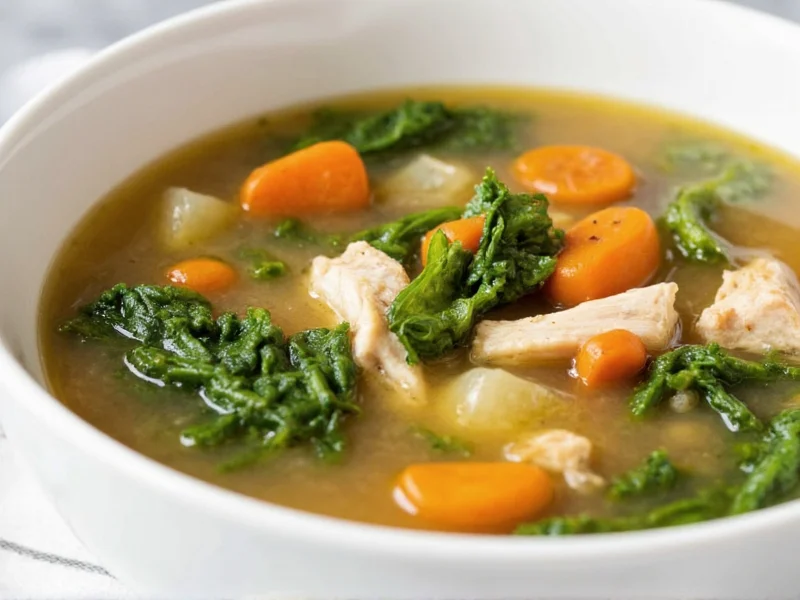The Nutritional Powerhouse in Your Bowl
Chicken kale soup isn't just comforting—it's scientifically backed nutrition in liquid form. The combination delivers a synergistic health boost you won't find in ordinary comfort foods. Kale contributes more than 684% of your daily vitamin K needs per cup, crucial for blood clotting and bone health. Chicken provides complete protein with all nine essential amino acids necessary for muscle repair and immune function.
What makes this soup exceptional is how the ingredients work together. The vitamin C in kale enhances iron absorption from the chicken, while the healthy fats in olive oil help your body utilize the fat-soluble vitamins A, E, and K abundant in the greens. This isn't just soup—it's functional food designed by nature.
Essential Ingredients and Their Roles
Creating exceptional chicken kale soup requires understanding each component's purpose. Don't substitute haphazardly—each ingredient serves a specific culinary and nutritional function:
| Ingredient | Function | Substitution Guidance |
|---|---|---|
| Chicken thighs (bone-in) | Creates richer broth through collagen release | Boneless works but yields less complex flavor |
| Curly kale | Withstands cooking without disintegrating | Lacinato works but requires earlier addition |
| Yellow onion | Provides natural sweetness when caramelized | Shallots offer more delicate flavor profile |
| Garlic (fresh) | Releases allicin when crushed properly | Never use pre-minced for maximum health benefits |
Step-by-Step Preparation Guide
Follow this professional technique for restaurant-quality chicken kale soup every time:
- Brown chicken properly: Pat thighs dry, season with salt, and sear in olive oil over medium-high heat for 5-6 minutes per side until golden. Remove and set aside.
- Build flavor foundation: In same pot, sauté diced onions until translucent (5 minutes), then add minced garlic and tomato paste, cooking 2 minutes until fragrant.
- Deglaze effectively: Pour in 1/2 cup dry white wine, scraping browned bits from bottom. Simmer until reduced by half.
- Create broth: Add 6 cups low-sodium chicken broth, bay leaves, and thyme. Return chicken to pot, submerging completely. Simmer covered for 25 minutes.
- Finish with greens: Remove chicken, shred, and return to pot. Stir in chopped kale and white beans. Cook 5-7 minutes until kale is tender but still vibrant green.
Proven Cooking Techniques for Perfect Results
Avoid these common mistakes that ruin otherwise good chicken kale soup:
- Adding kale too early: Kale becomes bitter and loses nutritional value when overcooked. Add during the final 5-7 minutes.
- Using pre-cut kale: Pre-washed kale often contains excess moisture that dilutes flavor. Wash and dry whole leaves yourself.
- Skipping the acid finish: A splash of fresh lemon juice just before serving brightens flavors and enhances nutrient absorption.
- Over-seasoning early: Salt concentration increases as soup reduces. Season in stages, with final adjustment before serving.
Variations for Different Dietary Needs
Adapt this versatile recipe to accommodate various dietary requirements without sacrificing flavor:
- Low-carb version: Omit white beans and add chopped celery root for similar texture without carbs
- Gluten-free assurance: Verify broth is certified GF (many contain hidden wheat)
- Vegan adaptation: Use mushroom broth with extra umami from nutritional yeast (though not traditional chicken kale soup)
- Keto-friendly: Increase healthy fats with avocado oil and add sliced avocado as garnish
Storage and Reheating Best Practices
Chicken kale soup excels as meal prep, but proper storage maintains quality:
- Cool completely before refrigerating (within 2 hours of cooking)
- Store in airtight containers for up to 4 days
- Freeze in portion-sized containers for up to 3 months
- Reheat gently over medium-low heat—never boil, which toughens chicken
- Add fresh kale and lemon juice after reheating for maximum nutrition
Frequently Asked Questions
Can I use frozen kale in chicken kale soup?
Yes, but with technique adjustments. Thaw frozen kale completely and squeeze out excess moisture to prevent dilution. Add frozen kale during the last 7-8 minutes of cooking. Note that texture will be softer than fresh kale, so avoid overcooking.
How do I prevent kale from becoming tough in soup?
Remove tough stems before chopping, and add kale during the final 5-7 minutes of cooking. For curly kale, massage leaves with a pinch of salt before adding to tenderize. Acidic ingredients like tomatoes or lemon juice added too early can also toughen kale fibers.
What's the best chicken cut for kale soup?
Bone-in, skin-on chicken thighs create the most flavorful broth due to higher collagen content. For quicker preparation, boneless thighs work well but require less cooking time (15-20 minutes). Avoid breast meat exclusively as it dries out during simmering—thighs maintain moisture better for soup applications.
Does cooking kale destroy its nutrients?
Brief cooking (5-7 minutes) actually increases bioavailability of certain nutrients like beta-carotene while preserving most vitamins. Water-soluble vitamins like C experience minimal loss with short cooking times. For maximum nutrition retention, add kale at the end and avoid overcooking beyond tender-crisp stage.
Can I make chicken kale soup in a slow cooker?
Yes, but with timing adjustments. Brown chicken and sauté aromatics first, then transfer to slow cooker with broth and simmer on low for 4-6 hours. Add shredded chicken and kale during the last 30 minutes to prevent overcooking. Slow cooking develops deeper flavor but requires careful timing with delicate ingredients like kale.











 浙公网安备
33010002000092号
浙公网安备
33010002000092号 浙B2-20120091-4
浙B2-20120091-4